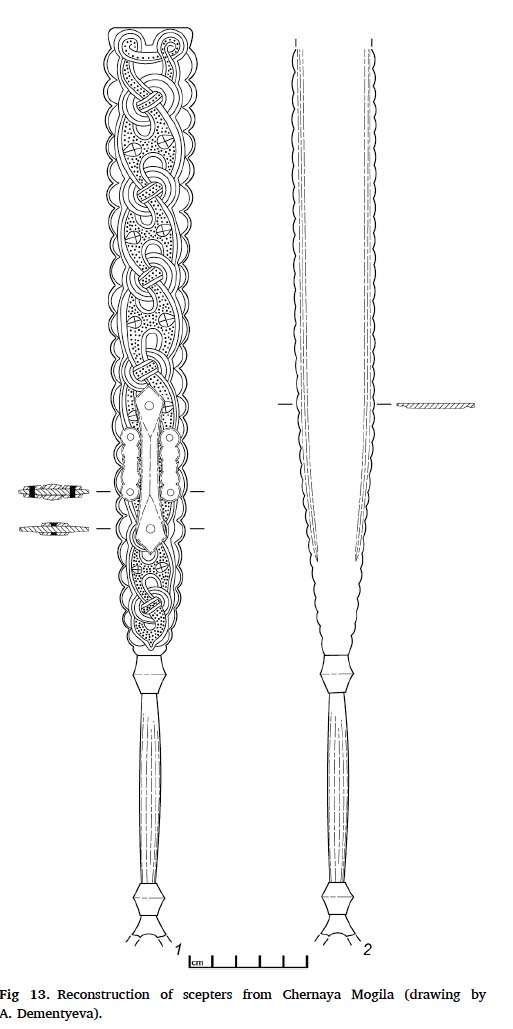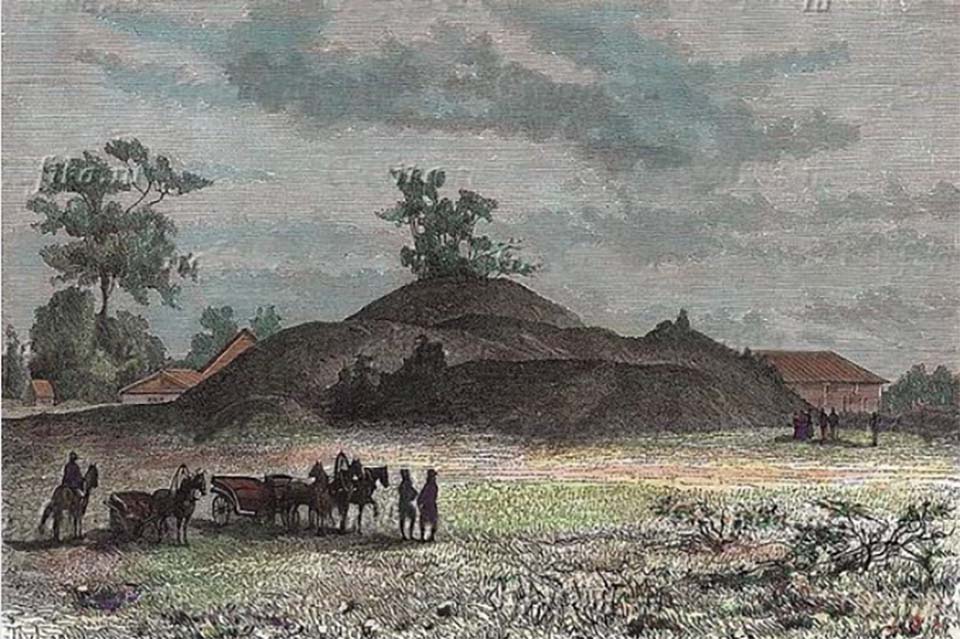A magnificent Viking burial took place at Chernihiv more than a thousand years ago. Recent studies of the find in the tomb has uncovered an extraordinary new “Viking artefact”
 With a height over 10 metres and a circumference of 170 metres, the so-called Black Grave is considered a National Ukrainian monument. But not just the sheer magnificence of the mound, but also the grave-goods commands a particular interest. Excavated in 1872-73, the archaeologists found two individuals, a man and a youngster. Beads have been identified, suggesting that a woman might have been buried together with the two men, whose cremated remains were laid to rest in a burial chamber similar to that in the northern mound at Jelling. The impressive assemblage of more than a hundred objects suggests the individuals securely belonged to the warrior or elite class. A recent series of modern scientific studies of the different pieces of grave goods have yielded a remarkable number of new insights into the culture of the demised at Chernihiv near the river of Desna, a contributory to the river Dnjepr sometime in the period between AD 960-1000. A solidus of Constantine VII (AD 945-959) presents a terminus post quem. C14 places the grave inside a spectrum of AD 980-1025. New studies corroborate this date from an artistic point of view.
With a height over 10 metres and a circumference of 170 metres, the so-called Black Grave is considered a National Ukrainian monument. But not just the sheer magnificence of the mound, but also the grave-goods commands a particular interest. Excavated in 1872-73, the archaeologists found two individuals, a man and a youngster. Beads have been identified, suggesting that a woman might have been buried together with the two men, whose cremated remains were laid to rest in a burial chamber similar to that in the northern mound at Jelling. The impressive assemblage of more than a hundred objects suggests the individuals securely belonged to the warrior or elite class. A recent series of modern scientific studies of the different pieces of grave goods have yielded a remarkable number of new insights into the culture of the demised at Chernihiv near the river of Desna, a contributory to the river Dnjepr sometime in the period between AD 960-1000. A solidus of Constantine VII (AD 945-959) presents a terminus post quem. C14 places the grave inside a spectrum of AD 980-1025. New studies corroborate this date from an artistic point of view.
Some of the objects are magnificent – a small gilded idol believed to be Thor, two helmets, chainmail, two Viking swords, some spearheads, two sabres of nomadic derivation, fittings for belts, and two drinking horns decorated with silver fittings.
One of the challenges has been the early “reimagination” of the find whereby factually unrelated artefacts were joined together. As part of a planned new presentation of the finds, non-destructive methods of analysis have been carried out to restore some of the original objects.
Two objects – a spearhead and a knife – have now been shown to be something totally different, namely sceptres with Mammen-style decoration dated to ca. 960-1025. Constructed by using a technique of laced and dotted silver wire inlay, they remind us of the Mammen ceremonial axe. The sceptre with the inlay had been repaired at the time of the burial. It measured 43.5 cm with a maximum of 4.5 cm., and a particular handle. Arguably, the smaller sceptre was copied by local craftsmen at the time of the burial to double of the grave goods of the two males
Hitherto, such sceptres have not been found in Viking warriors’ graves, but they are known from coins, including the coins of Vladimir the Great (AD 987-1015). The archaeologists suggest that the two newly identified sceptres were dynastic insignia. Were the sceptres signs of the status of “Kniaz” granted to dynastic relatives by the kings at Kyiv?
The small figurine

The small idol or figurine has been carefully studied in another part of the new studies. During this non-destructive exploration, archaeologists have found that the figurine originally was gilded. The tiny statuette measures 2 cm in diameter at the bottom and 4-5 cm in height (no precise measurements are given in the literature.) New studies have shown additional details indicating a belt with a sabre or knife attached. The figure appears to be dressed in a loincloth and a fitted tunica. The figure holds its long beard in one hand.
The figurine looks like a small figurine found at Rällinge in Sweden in 1904. Due to the erect penis, this statuette has tentatively been identified as Frey. It dates to c. AD 1000. It measures 6.9 cm in height. This man is tattooed on the back and sports a conical helmet, like those found at Chernaya Mogila. Similar to the small idol from Chernaya Mogila, the man from Rällinge sports a considerable moustache and a long beard. Another such figure mentioned in the literature is the Eyrarland statuette, found in 1816 in Iceland, and measuring 6.7 cm. Again we meet a figure with a conical helmet, a moustache and an impressive beard. However, this statuette sits on a chair and seems not to grasp his beard but rather a wind instrument. Some archaeologists have identified the figurines as gaming pieces in the Viking game of hnefatafl.
However, in a recent review of the small figurines of males grasping their beards, they are identified as Thor raising a wind by blowing down into his whiskers “and sounding the voice of the beard”. This ia also the accepted identification of the figurine from Chernya Mogila.
To conclude: The newly identified sceptre with Mammen decoration supplements the other finds at Chernya Mogila with Viking derivation. Does this also pertain to the two remarkable drinking horns, with their unique silver decoration?

VISIT (in the future):
The objects are kept in the collections in the State Historical Museum in Moscow, to which they were donated in the late 19th century. At present – because of the ongoing war, neither the museum can be visited nor the city of Chernihiv, which is currently undergoing devastating and destructive bombardments by the Russian army during the war in Ukraine.
SOURCES:
‘Barbarian Scepters’ of the Viking Age from the Chernaya Mogila burial mound at Chernigov (present-day Ukraine)
By V.V. Murasheva, S.Yu. Kainov, E.S. Kovalenko, K.M. Podurets, V.P. Glazkov, M.M. Murashev, I.A. Chichaev, N.N. Presniakova, E.Yu. Tereschenko, V.M. Retivov and E.B. Yatsishina
In Journal of Archaeological Science: Reports (2021) vol. 37/102946
By A. Y. Lobodaa, N. N. Kolobylinaa, E. Y. Tereshchenkoa, V. V. Murashevac, A. O. Shevtsovc, L. Vasileva, V. M. Retivovd, P. K. Kashkarova, and E. B. Yatsishinaa
In: Crystallographic methods in Humanitarian Sciences (2018) Vol 63/6 pp 1034-1042
Natural Scientific Methods in studying Cultural Heritage Sites: X-ray, Synchrotron, and Neutron Imaging of Metal Artifacts from the Chernaya Mogila (Black Grave) Burial Mound
S. Kovalenko, K. M. Podurets, M. M. Murashev, V. P. Glazkov, S. I. Kartashov, I. A. Chichaev, S. Yu. Kainov, V. V. Murasheva, E. Yu. Tereschenko, E. B. Yatsishina & M. V. Kovalchuk
In: Nanotechnologies in Russia (2020) vol 15, pp. 572–583
READ ALSO:
Thor the Wind-Raiser and the Eyrarland Image
by Richard Perkins
Viking Society for Northern Research 2001.




